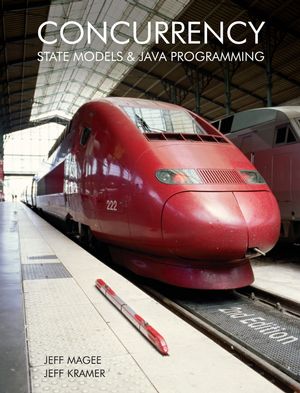|
Textbook
Concurrency: State Models and Java Programs, 2nd EditionISBN: 978-0-470-09355-9
Hardcover
432 pages
June 2006, ©2006
 This is a Print-on-Demand title. It will be printed specifically to fill your order. Please allow an additional 10-15 days delivery time. The book is not returnable.
|
||||||
Acknowledgments.
1. Introduction.
1.1 Concurrent Programs.
1.2 The Modeling Approach.
1.3 Practice.
1.4 Content Overview.
Summary.
Notes and Further Reading.
2. Processes and Threads.
2.1 Modeling Processes.
2.2 Implementing Processes.
Summary.
Notes and Further Reading.
Exercises.
3. Concurrent Execution.
3.1 Modeling Concurrency.
3.2 Multi-Threaded Programs.
Summary.
Notes and Further Reading.
Exercises.
4. Shared Objects and Mutual Exclusion.
4.1 Interference.
4.2 Mutual Exclusion in Java.
4.3 Modeling Mutual Exclusion.
Summary.
Notes and Further Reading.
Exercises.
5. Monitors and Condition Synchronization.
5.1 Condition Synchronization.
5.2 Semaphores.
5.3 Bounded Buffers.
5.4 Nested Monitors.
5.5 Monitor Invariants.
Summary.
Notes and Further Reading.
Exercises.
6. Deadlock.
6.1 Deadlock Analysis.
6.2 Dining Philosophers Problem.
Summary.
Notes and Further Reading.
Exercises.
7. Safety and Liveness Properties.
7.1 Safety.
7.2 Single-Lane Bridge Problem.
7.3 Liveness.
7.4 Liveness of the Single-Lane Bridge.
7.5 Readers–Writers Problem.
Summary.
Notes and Further Reading.
Exercises.
8. Model-Based Design.
8.1 From Requirements to Models.
8.2 From Models to Implementation.
Summary.
Notes and Further Reading
Exercises.
9. Dynamic Systems.
9.1 Golf Club Program.
9.2 Golf Club Model.
9.3 Fair Allocation.
9.4 Revised Golf Ball Allocator.
9.5 Bounded Overtaking.
9.6 Bounded Overtaking Golf Ball Allocator.
9.7 Master–Slave Program.
9.8 Master–Slave Model.
Summary.
Notes and Further Reading.
Exercises.
10. Message Passing.
10.1 Synchronous Message Passing.
10.2 Asynchronous Message Passing.
10.3 Rendezvous.
Summary.
Notes and Further Reading.
Exercises.
11. Concurrent Architectures.
11.1 Filter Pipeline.
11.2 Supervisor–Worker.
11.3 Announcer–Listener.
Summary.
Notes and Further Reading.
Exercises.
12. Timed Systems.
12.1 Modeling Timed Systems.
12.2 Implementing Timed Systems.
12.3 Parcel Router Problem.
12.4 Space Invaders.
Summary.
Notes and Further Reading.
Exercises.
13.ihl Program Verification.
13.1 Sequential Processes.
13.2 Modeling Condition Synchronization.
13.3 Modeling Variables and Synchronized Methods.
13.4 Bounded Buffer Example.
13.5 Readers–Writers Example.
Summary.
Notes and Further Reading.
Exercises.
14. Logical Properties.
14.1 Fluent Propositions.
14.2 Temporal Propositions.
14.3 Fluent Linear Temporal Logic (FLTL).
14.4 Database Ring Problem.
Summary.
Notes and Further Reading.
Exercises.
Appendix A: FSP Quick Reference.
Appendix B: FSP Language Specification.
Appendix C: FSP Semantics.
Appendix D: UML Class Diagrams.
Bibliography.
Index.



